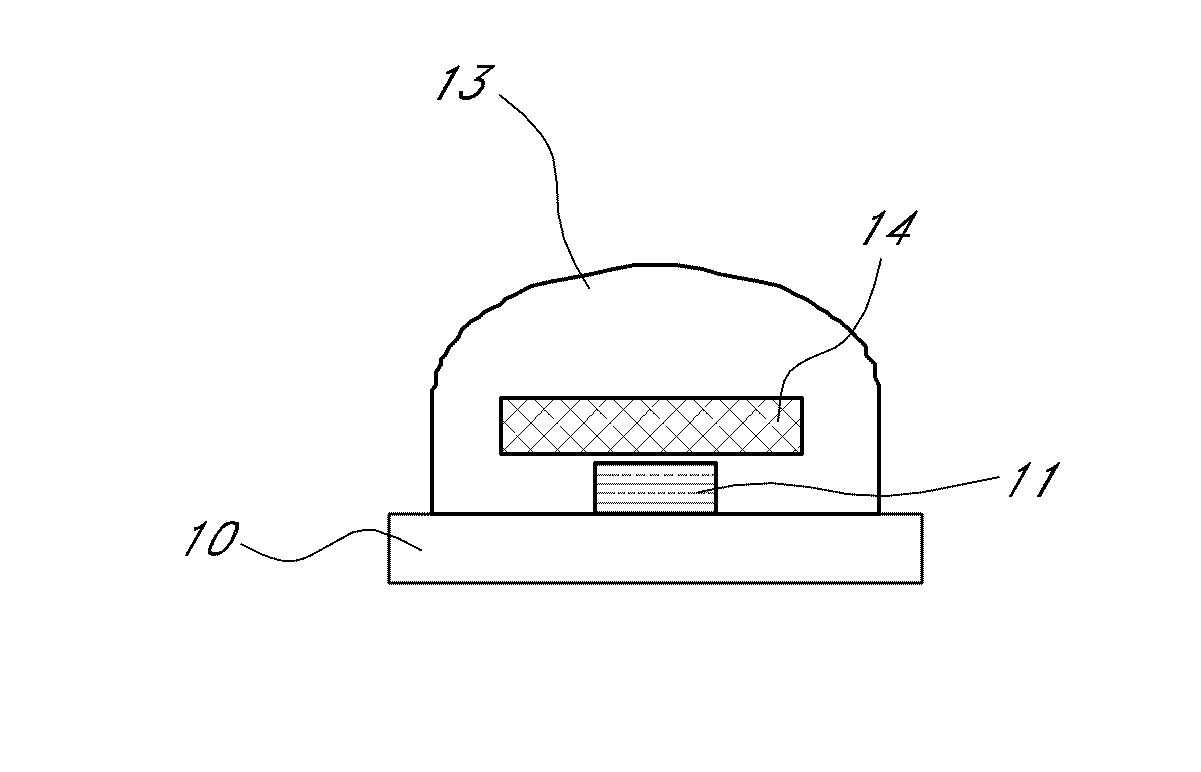Light emitting device with translucent ceramic plate
a technology of translucent ceramics and light emitting devices, which is applied in solid-state devices, discharge tubes/lamp details, light sources, etc., can solve the problems of reduced radiation transparency, strong light scattering, and reduced luminosity of ceramic members, so as to improve the luminance intensity of light emitting devices.
- Summary
- Abstract
- Description
- Claims
- Application Information
AI Technical Summary
Benefits of technology
Problems solved by technology
Method used
Image
Examples
example 1
Preparation of Raw Particles by Using Inductively Coupled RF Thermal Plasma Pyrolysis
[0065]0.14923 mol (14.29 g) of Yttrium (III) nitrate hexahydrate (99.9% pure, Sigma-Aldrich), 0.25 mol (23.45 g) of Aluminum nitrate nonahydrate (99.97% pure, Sigma-Aldrich), and 0.015 mol (0.081 g) of Cerium (III) nitrate hexahydrate (99.99% pure, Sigma-Aldrich) were dissolved in 250 ml of deionized water, followed by ultrasonication for 30 min to prepare the transparent precursor solution. This precursor solution of 0.4 M was carried into a plasma reaction chamber via an atomization probe using a liquid pump.
[0066]All deposition experiments were conducted with an RF induction plasma torch (TEKNA Plasma System, Inc PL-35) operating at 3.3 MHz. For the deposition experiments, the chamber pressure was kept at around 25 kPa-35 kPa, and the RF generator plate power was in the range of 10-12 kW. Both the plate power and the deposition pressure are user-controlled parameters. Argon was introduced into th...
example 2
[0073]Sintered ceramic plate samples were made using annealed nano-powders instead of as-synthesized nano-powders from RF plasma. The nano-powder prepared by previously mentioned RF plasma method was annealed at 1200° C. for 2 hrs in a H2 / N2=3% / 97% ambient using a quartz tube furnace (MTI Corporation GSL-1600X) at 1 atm. The rate of increase of temperature was 10° C. / min. After the annealing, yellowish colored powder was obtained and yttrium aluminum garnet crystalline phase was determined by XRD. The average diameter after annealing obtained from BET measurement was 129 nm.
[0074]The same procedures for preparing the sintered ceramic plates described in Example 1 were followed. The loading quantities of dry powders spread out into die set with 3 mm of diameter were 45.0, 47.5, 50.0, 52.5, 55.0, and 57.5 mg. The crystalline phase of all ceramic plate samples was determined as yttrium aluminum garnet by XRD. The thicknesses of ceramics plates were summarized in Table 2.
[0075]In the sa...
example 3
[0085]Multiphasic sintered ceramic plate: sample 3-1 was made using the RF plasma method described in Example 1. The precursor solution was prepared by dissolving 0.14923 mol (14.29 g) of Yttrium (III) nitrate hexahydrate (99.9% pure, Sigma-Aldrich), 0.25625 mol (24.03 g) of Aluminum nitrate nonahydrate (99.97% pure, Sigma-Aldrich), and 0.015 mol (0.081 g) of Cerium (III) nitrate hexahydrate (99.99% pure, Sigma-Aldrich) in 250 ml of deionized water, followed by ultrasonication for 30 min. The nano-powders prepared using this precursor solution have additional material Al2O3 for forming the second phase. The nano-powders were annealed at 1200° C. for 2 hrs in a H2 / N2=3% / 97% ambient. The rate of the increase of temperature was 5° C. / min. After the annealing, yellowish colored powder was obtained and yttrium aluminum garnet crystalline phase was determined by XRD. Small XRD peaks of Al2O3 phase were also detected in accordance with the amount of second phase material in the Al-rich com...
PUM
| Property | Measurement | Unit |
|---|---|---|
| first peak wavelength | aaaaa | aaaaa |
| total light transmittance | aaaaa | aaaaa |
| particle size | aaaaa | aaaaa |
Abstract
Description
Claims
Application Information
 Login to View More
Login to View More - R&D
- Intellectual Property
- Life Sciences
- Materials
- Tech Scout
- Unparalleled Data Quality
- Higher Quality Content
- 60% Fewer Hallucinations
Browse by: Latest US Patents, China's latest patents, Technical Efficacy Thesaurus, Application Domain, Technology Topic, Popular Technical Reports.
© 2025 PatSnap. All rights reserved.Legal|Privacy policy|Modern Slavery Act Transparency Statement|Sitemap|About US| Contact US: help@patsnap.com



